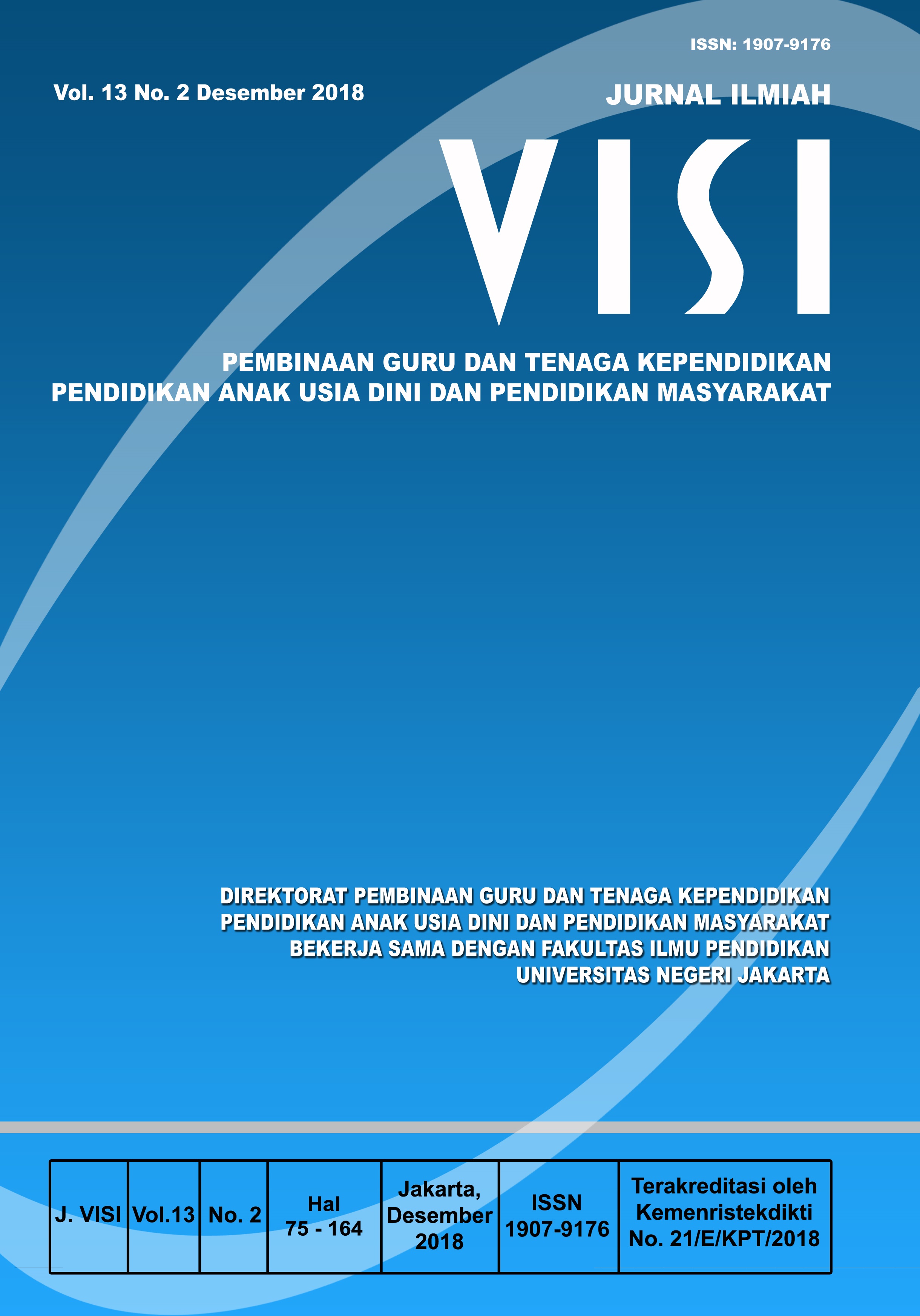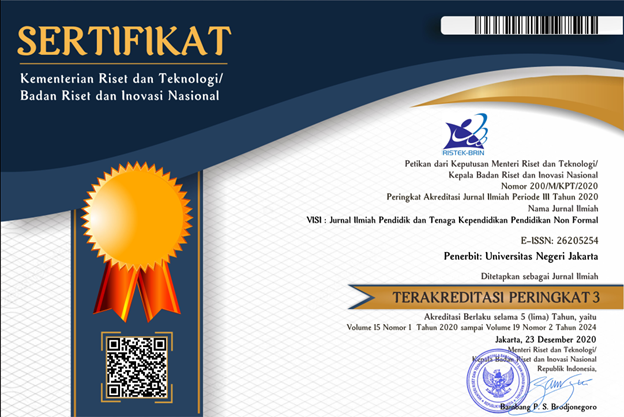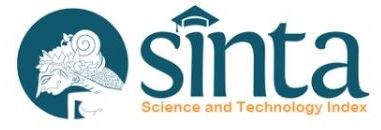PENDIDIKAN KESELAMATAN DIRI ANAK USIA DINI
(Studi Kasus di Kelompok Bermain (KB) Gaharu Plus Kutai Kartanegara)
Abstract
The background of this study is the frequent occurrence of early childhood accidents. Children as objects of protection need to be equipped with knowledge and attitudes and behaviors related to their safety. One way to avoid early childhood hazards is to increase their understanding of hazards and ways to overcome hazards through personal safety education. The study aimed to describe the implementation of early childhood self-education education and find out the results of the assessment in the Gaharu Plus KB. This research is a case study with a qualitative exploratory approach. This research was conducted from July to September 2018 involving all children (63 people). The results showed that the method of self-safety education in KB Gaharu Plus was PAUD Watching method. This method is the result of the development of the model at BP PAUD & Dikmas East Kalimantan. The stages include learning hazards, hazard surveys, hazard maps and ways to avoid hazards. Children can attend the process of self-education education. However, there were still 18.60% of new children began to develop in telling the results of the description related to potential hazards. Personal safety education in KB Gaharu Plus can improve children’s understanding of hazards and how to avoid them.
References
Amelia, L. (2012). Metode kindergarten watching siaga bencana gempa bumi terhadap stimulasi kecerdasan visual spasial dan kecerdasan kinestetik anak usia dini di TK Syeikh Abdurrauf Blang Oi Banda Aceh. Jurnal Tematik, 5(2), 165-179. doi: https://doi.org/10.24114/jt.v5i02.3207
Arikunto, S. (1995). Manajemen penelitian. Jakarta: Rineka Cipta.
Balitbangkes Kementerian Kesehatan RI. (2013). Riset kesehatan dasar. Diakses melaui http://www.depkes.go.id/resources/download/general/Hasil%20Riskesdas%202013.pdf
Bolig, G., Wahl, H.A., & Svendsen, M.V. (2009). Primary school children are able to perform basic life-saving first aid measure. Journal of Resuscitation, 80, 689-692.
Direktorat Pembinaan PAUD Dirjen PAUD & Dikmas. (2015). Pedoman pengelolaan pembelajaran pendidikan anak usia dini: Pedoman implementasi kurikulum 2013 PAUD. Jakarta: Kemdikbud.
Direktorat pembinaan PAUD Dirjen PAUD & Dikmas. (2015). Petunjuk teknis penyelenggaraan PAUD holistik integratif di satuan PAUD. Jakarta: Kemdikbud.
Effendi, A. (2016). Kegiatan menggambar pada anak usia dini. Diakses melalui http://paudunia.blogspot.co.id pada tanggal 16 September 2017.
Hartati, S. (2005). Perkembangan belajar pada usia dini. Jakarta: Departemen Pendidikan Nasional.
Indarwati, R.D. (2011). Hubungan antara pengetahuan dan sikap orang tua tentang bahaya cedera dan cara pencegahannnya dengan praktik pencegahan cedera pada anak usia toddler di kelurahan Blumbang Kecamatan Tawangmangu Kabupaten Karanganyar. GASTER, 8(2), 750-764. http://www.jurnal.stikes-aisyiyah.ac.id/index.php/gaster/article/view/26
Istifada, R., & Permatasari, H. Keselamatan diri anak SMP terhadap resiko terjadinya kecelakaan di sekolah. Diakses melalui http://lib.ui.ac.id/naskahringkas/2015-09/S52892-Rizkiyani%20Istifada pada tanggal 31 Oktober
2018.
Istiqomah, A. (2015). Upaya meningkatkan perhatian anak melalui metode bercerita dengan media boneka tangan pada anak kelompok A TK ABA Jogoyudan Yogyakarta. Pendidikan Guru PAUD S-1, IV(7), 1-8. http://journal.student.uny.ac.id/ojs/index.php/pgpaud/article/view/365
Kuschithawati, S., Magetsari, R., & Ng, N. (2007). Faktor risiko terjadinya cedera pada anak usia sekolah dasar. Berita Kedokteran Masyarakat, 23(3), 131-141. doi: https://doi.org/10.22146/bkm.3620
Lamb, et.al. (2006). Children’s acquisition and retention of safety skills: the lifeskills program. Injury Prevention,12(3),161-165. doi: http://dx.doi.org/10.1136/ip.2005.010769
Muchtamadji, A. (2004). Konsep dan penerapan pendidikan keselamatan. Jakarta: Direktorat Jenderal Olahraga.
Nugratmaja, A.S. (2011). Penatalaksanaan pencegahan kecelakaan anak usia prasekolah di Dusun Geblagan Kecamatan Kasihan Kabupaten Bantul. Tesis. Yogyakarta: Universitas Muhammadiyah Yogyakarta.
Ogawa, Y. (2005). Town watching for disaster reduction for effective and successful risk communication. United Nations World Conference on Disaster Reduction Kobe, Japan.
OHSAS. (2007). Sistem manajemen keselamatan dan kesehatan kerja-persyaratan (occupational health and safety management systemsrequirements). Diakses melalui https://nuruddinmh.files.wordpress.com/2013/08/
ohsas-18001-2007-dual-language.pdf pada tanggal 22 Oktober 2018.
Sandy, W. (2012). Tingkat pengetahuan tentang keselamatan pada siswa sekolah dasar. Skripsi. Depok: Universitas Indonesia.
Sari, S. A., & Khatimah, K. (2015). The application of school watching method to increase the earthquake disaster preparedness of primary school students MIN Blang Mancung, Aceh. Journal of Education and Learning, 9(3), 241-245. doi: http://dx.doi.org/10.11591/edulearn.v9i3.2301
Sumargi, A.M., dkk. (2005). Apa yang diketahui anakanak sekolah dasar tentang keselamatan dirinya: Studi pendahuluan tentang pemahaman akan keselamatan diri. INSAN Media Psikologi, 7(3), 226-249. http://journal.
unair.ac.id/INSAN@apa-yang-diketahui-anakanak-sekolah-dasar-tentang-keselamatandirinya-article-1167-edia-8-category-10.html
Sumargi, A.M., & Simanjuntak, E. (2010). Pemahaman dan sikap orang tua pada keselamatan diri anak-anak usia dini. Temu Ilmiah Nasional IPPI, IPS & Fakultas Psikologi UNAIR.
Vinje, M.P. (1991). Children as pedestrian: abilities and limitations. Accident, Analysis and Prevention, 13(3), 225-240. doi: https://doi.org/10.1016/0001-4575(81)90006-3
Authors who publish with this Journal agree to the following terms:
- Author retain copyright and grant the journal right of first publication with the work simultaneously licensed under a creative commons attribution licensethat allow others to share the work within an acknowledgement of the work’s authorship and initial publication of this journal.
- Authors are able to enter into separate, additional contractual arrangementfor the non-exclusive distribution of the journal’s published version of the work (e.g. acknowledgement of its initial publication in this journal).
- Authors are permitted and encouraged to post their work online(e.g. in institutional repositories or on their websites) prior to and during the submission process, as it can lead to productive exchanges, as well as earlier and greater citation of published works.
- Users/public use of this website will be licensed to CC BY-NC-SA Creative Commons Attribution-NonCommercial-ShareAlike 4.0 International License









